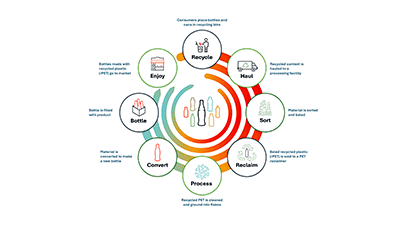
Photo courtesy of The Coca-Cola Co.
The Coca‑Cola Co. is introducing redesigned, lighter-weight polyethylene terephthalate (PET) bottles for its sparkling beverage portfolio in the U.S. and Canada as part of its broader commitment to create a circular economy for its packaging.
The company’s 12-, 16.9- and 20-ounce bottles of Coca‑Cola, Sprite and Fanta as well as Minute Maid Refreshments and Minute Maid Aguas Frescas feature new shapes that require less raw material to produce, according to The Coca-Cola Co. This is the first time in a decade the bottles have been redesigned.
The Coca-Cola Co. designed three different bottle shapes in the three different sizes, with the Coca-Cola and Sprite bottles having their own bottle designs, while all of the sparkling brands, Minute Maid Refreshments and Minute Maid Aguas Frescas have another design.
RELATED: Two Coca-Cola brands make packaging changes to support circularity
“We’ve been continuously working to ‘right-weight’ our bottles, incrementally going from 27 to 21 grams over the last 10 years,” says Alejandro Santamaria, senior director for global packaging development and innovation. “But we’d reached the ‘floor’ with our previous designs. Our breakthrough innovations in modeling technology, which reduce the weight of our bottles to 18.5 grams, represent a major step in reducing the amount of materials used while preserving the durability and functionality of our packaging and, most importantly, the quality and taste standards of our beverages.”
PET bottles are made by injecting heated liquid resin into preforms, which are inflated into bottle molds with the final intended shape.
“The secret is finding the right preform design, combined with bottle shape features, that allow you to lightweight without compromising quality,” Santamaria says, noting the designs apply to the company’s virgin and 100 percent-recycled plastic bottles. “This is especially critical with sparkling beverages, which must maintain specific carbonation levels to preserve taste when opened.”
The new bottles, which will gradually roll out across the U.S. and Canada this year, will deliver sustainability benefits for The Coca‑Cola Co. and its bottling partners, according to the company. The transition is projected to reduce new plastic use by the equivalent of approximately 800 million bottles in 2025 and to reduce carbon emissions in an amount equivalent to taking more than 17,000 cars off the road for one year.
It supports the company’s World Without Waste goals of designing all packaging to be recyclable by 2025, using 50 percent-recycled content by 2030, collecting a bottle or can for each one it produces by 2030 and reducing virgin plastic use derived from nonrenewable sources, which contribute to creating a circular economy for packaging material and reducing waste and emissions, The Coca-Cola Co. says.
The new design potentially could be applied to multiserve 2-liter and 24-ounce PET bottles, with the company noting that testing is underway. Additionally, a significant portion of the Coca‑Cola North America still beverages portfolio, including sports drinks, enhanced waters and teas, will transition from hot-fill to aseptic processing, which uses less plastic and energy by filling beverages into presterilized containers.
“We intentionally started with our highest-selling SKUs,” Santamaria says. “And we are not leaving any rock unturned when it comes to reducing our per-package use of PET material.”
In addition to this design change, The Coca-Cola Co. is working with Circular Solutions Advisors, Roswell, Georgia; State Farm Stadium in Glendale, Arizona; Rocket Mortgage FieldHouse in Cleveland; and nearby material recovery facilities (MRFs) and PET recyclers to ensure recycling infrastructure is in place at the Final Four tournament venues and to increase the amount of material collected.

At this year’s Final Four events, 200 additional recycling bins will be installed to increase access and encourage easy recycling, with Green Teams helping fans remember to throw their bottles and cans in recycling bins. Fans also will find recycling reminders that explain how the bottles and/or cans they place in recycling bins will be recycled.
Fans can place their beverage bottles and/or cans in the “Who’s Your Champion” recycling bin, with four slot options that represent their favorite to win the tournament.
Additionally, Tourney Town fans can visit The Coca-Cola Co.’s Recycle for Merch activation to recycle their bottles to redeem merchandise.
The company says State Farm Stadium, Rocket Mortgage FieldHouse, Cleveland’s Huntington Convention Center and more than 90 other properties will maintain their status as a certified closed loop for beverage packaging beyond the 2024 championship.
This isn’t the first time The Coca-Cola Co. has worked with the NCAA Men’s & Women’s Final Four tournament venues to ensure they have a certified closed loop for beverage packaging. In 2022, the company recovered more than 40,000 pounds of recycled materials at the Women's Final Four at Target Center in Minneapolis, while in 2023, more than 129,000 bottles and cans were recycled during the Men’s Final Four events that took place throughout Houston.
Latest from Recycling Today
- Connect Work Tools names new service manager
- Aaron Industries expands color capability
- Massachusetts voters support modernizing state Bottle Bill
- Oceana Canada poll shows support for single-use plastics ban
- Enviri releases annual ESG report
- Umicore sees lower revenues across all business groups for first half of year
- NEO Battery Materials, Lotus Energy Recycling to partner
- Partnership aims to convert industrial plastic scrap to synthetic graphene





